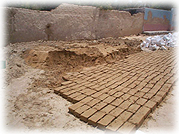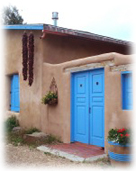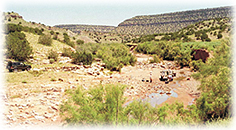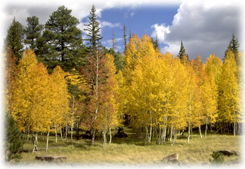|
|||
 Abiquiu AbiquiuLocated in Northern New Mexico, about 50 miles north of Santa Fe, Abiquiu boasts stunning red rock formations. The town is best known as the home of artist Georgia O'Keeffe, who lived at her Ghost Ranch residence from 1949 until her death (at the age of 98) in 1986. Now the home to numerous artists, Abiquiu hosts a studio tour each year on Columbus Day weekend. (~Aimee) Acequia Community operated, man-made waterways used for irrigation, acequias carry snow runoff or river water to fields. Originally brought to Spain by the Arabs, the canal systems were adapted by Spanish settlers for use in the Southwest. (~Aimee)  Adams, Ansel Adams, AnselAnsel Adams (February 20, 1902 – April 22, 1984), photographer and environmentalist, was born in San Francisco, California. At age four, an aftershock of the great earthquake and fire of 1906 threw him to the ground, breaking his nose and distinctly marking him for life. Captivated by nature at an early age, Adams would become its champion through his photographic works. Adams’ famous photographs of Yosemite National Park, taken on yearly visits made from 1916 until his death, were accomplished only after arduous climbs with his tripod and 8 x 10 camera. Adams also made several lengthy trips to the Southwest, where he collaborated with Mary Austin on the magnificent limited edition book, “Taos Pueblo,” published in 1930. Many of his most famous works were made in Northern New Mexico, including "Moon over Hernandez." Several years later, he would give up his previous pictorial style of photography for the modernist "straight photography," ultimately becoming its most articulate devotee. Adams’ technical mastery of photography is legendary. His famous and complex "zone system" of exposure would ultimately become a basic tool of all photographers. His profound commitment to promoting photography as a fine art played a key role in the establishment of the first museum department of photography, at the Museum of Modern Art in New York. In addition, he was an unrelenting activist for the cause of wilderness and the environment, and his photographs would become the symbols of the conservation movement. (~Aimee)  Adobe AdobeDefinition: “a kind of clay used as a building material, typically in the form of sun-dried bricks; a brick of such a type or a building constructed from such material.” Origin: “mid-18th century: from Spanish, adobar meaning ‘to plaster.’” Adobe has long been the traditional building material of the Southwest. Structures made from it are undulating and sculptural in nature, yet their mass gives them a sense of permanence and timelessness. The word adobe originated in the Arabic language and was brought to America by Spanish colonists at the end of the 15th century. It is used to refer to the earth from which structures are built, the structures themselves, and the unbaked clay bricks made from the earth. In New Mexico, archaeologists have discovered remnants of adobe walls built by Pueblo Indians that date back to 1200 AD, 400 years before the arrival of the Spanish. From that time, through the 15th century, there is evidence of two types of earthen walls. One was coarse adobe, which started with a stiff mixture of mud and was blended with anything from stones to pot shards. The mud was applied by the handful, layer on top of layer, until the desired wall height had been reached. A more sophisticated method made use of hand-formed, unbaked clay bricks. When the bricks were dry, mud mortar was used to hold the bricks in place on the wall. Believe me, nothing can take the place of the feeling you get when you enter an old, well-maintained adobe structure. In the summer, it’s akin to walking into a cool, refreshing cave; and in the winter, there is nothing more delightfully cozy than sitting in front of an authentic kiva fireplace. Ultimately, it’s a big part of the process of truly being in touch with the wondrous and sacred land that is America’s Great Southwest. (~Jean) NOTE: See our special feature about Adobe.  Adobe Architecture (see Adobe) Adobe Architecture (see Adobe)Ancient Indians used adobe (a mixture of sand, soil, straw and water) to build their villages. Spanish settlers were familiar with the material from use in their homeland and readily adopted it in the American Southwest. It was ideal for building in an area that had few large hardwood trees for lumber. The Spanish added refinements, making the adobe into bricks and creating the distinctive curved corner fireplaces that can heat an entire room. The earliest true adobe homes consisted of a few small rooms with the widths being determined by the length of the vigas used as ceiling beams. Over the vigas, latillas (cedar poles) were laid and flat earthen roofs topped it off. Canales were a crucial feature of adobe construction, as they directed water through a parapet off the rooftop. Poorly maintained or located canales resulted in rapid destruction of the fragile sun-baked adobe bricks. Original adobe walls were very thick, often three to four feet deep, with few windows in order to keep out cold and heat. Today’s modern adobe-style homes are built to withstand the effects of rain and weather, but still incorporate many of the original design elements of true adobe homes (with the exception of very thick walls). A cement and plaster mixture is hand troweled over a frame structure, which is insulated and covered with wire mesh before the plaster is applied. Canales are still used to drain water from the rooftops, which are often flat. Despite modern innovations, the ancient art of adobe architecture lives on throughout the Great Southwest. (~Jean) NOTE: See our special feature on Adobe Architecture.  Alpaca AlpacaA long-haired mammal related to the llama. Indigenous to the high Andean Plateau, they played a central role in the Incan culture. Alpacas produce one of the world's finest and most luxurious natural fibers. It is clipped from the animal without causing it injury. Soft as cashmere and warmer, lighter and stronger than wool, it comes in more colors than any other fiber-producing animal (approximately 22 basic colors with many variations and blends). This cashmere-like fleece, once reserved for Incan royalty, is now enjoyed by spinners and weavers around the world. First imported to the United States in 1984, Alpacas are now being successfully raised throughout the country. They are quite popular in Northern New Mexico, where they are also enjoyed and admired for their gentle nature. (~Aimee) Anglo A European tribe, better known after the Saxon raids of England combined the two tribes as Anglo-Saxon. The word is commonly employed in New Mexico in reference to all Caucasians of European descent. (~Aimee) Arroyo  Definition: "a steep-sided gully cut by running water in an arid or semi-arid region." An arroyo is a nearly vertically walled, flat floored stream channel that forms in fine, cohesive, easily eroded material. Arroyos can cut as deeply as 65 feet into the valley floor, are often wider than 165 feet, and can be hundreds of miles long. Arroyos exist throughout the Western United States, but are most common in arid and semi-arid climates in the Southwest. They are found throughout New Mexico. Definition: "a steep-sided gully cut by running water in an arid or semi-arid region." An arroyo is a nearly vertically walled, flat floored stream channel that forms in fine, cohesive, easily eroded material. Arroyos can cut as deeply as 65 feet into the valley floor, are often wider than 165 feet, and can be hundreds of miles long. Arroyos exist throughout the Western United States, but are most common in arid and semi-arid climates in the Southwest. They are found throughout New Mexico.The rapid widening and deepening of arroyos have both changed the physical environment and been a costly nuisance in the West since settlement began in the mid-1800s. From 1870 to 1890 the number of livestock in New Mexico alone increased from 300,000 to 2,300,000. Valley floors, which were the most dependable forage areas for the animals, were quickly overgrazed. The fragile vegetation was consumed, and the soil was compacted and left extremely susceptible to erosion. To further exacerbate the soil conditions, both humans and livestock created trails along stream channels and nearby hillsides forming small ditches, leaving the land surface susceptible to arroyo formation. (~Aimee) Aspen (Tree)  A tree with rounded, long-stalked, and typically coarsely-toothed leaves that tremble in even a slight breeze. There are several species, in particular the North American quaking aspen, and the bigtooth aspen. The aspen is one of the few hardwood trees that thrive in the arid sections of the Western U.S., such as New Mexico. Throughout the summer, the silver underlining of the aspen leaves fluttering in the wind is a sign of a storm brewing, and in the autumn, you will find huge swaths of golden aspens amidst the dark green conifers which cover the southern Rockies. A tree with rounded, long-stalked, and typically coarsely-toothed leaves that tremble in even a slight breeze. There are several species, in particular the North American quaking aspen, and the bigtooth aspen. The aspen is one of the few hardwood trees that thrive in the arid sections of the Western U.S., such as New Mexico. Throughout the summer, the silver underlining of the aspen leaves fluttering in the wind is a sign of a storm brewing, and in the autumn, you will find huge swaths of golden aspens amidst the dark green conifers which cover the southern Rockies.Compared to coniferous forests, aspen stands have a richly diverse number of species thriving within their ecosystems. An aspen canopy typically allows more sunlight to reach the forest floor than do conifers, and stands of aspens are renowned for the wildflowers found within them. The leaves, twigs and bark are highly nutritious, and deer and elk use them for overwintering. Black bears, cottontails, porcupine, and snowshoe hares feed on bark, buds, and foliage, and grouse and quail eat the winter buds. Small mammals, such as shrews, mice, and voles abound. And, of course, aspen is a favorite food and building material for the North American beaver. The layered structure of an aspen grove is popular with birds. Snags provide perches for birds of prey, and sites for cavity nesters. Aspen stands across the American West are home to such species as the warbling vireo; shrub nesters, like the flycatcher; cavity nesters, like the mountain bluebird; and ground nesters, like the hermit thrush; as well as hummingbirds and birds of prey. (~Aimee)  A Bit of Aspen Movie Trivia: In the film "Phenomenon," John Travolta's character finds himself the center of controversy after an unexplainable incident leads to a tremendous expansion of his mental faculties. In a meeting with the townspeople, he attempts to smooth over the misunderstandings by imparting some of the new wealth of information he has learned, and demonstrating that everything and everyone is connected. One of the examples he uses is the fact that the largest organism in the world is a a grove of aspen trees in Colorado. (~Aimee) A Bit of Aspen Movie Trivia: In the film "Phenomenon," John Travolta's character finds himself the center of controversy after an unexplainable incident leads to a tremendous expansion of his mental faculties. In a meeting with the townspeople, he attempts to smooth over the misunderstandings by imparting some of the new wealth of information he has learned, and demonstrating that everything and everyone is connected. One of the examples he uses is the fact that the largest organism in the world is a a grove of aspen trees in Colorado. (~Aimee)Pictured top to bottom: 1} Scenery in the Abiquiu area; 2} Photographer Ansel Adams; 3} Adobe bricks; 4} An adobe house in Santa Fe, New Mexico; 5} Alpacas at home on a New Mexico farm; 6} Arroyo south of Santa Fe, New Mexico; 7} Aspen trees in the fall |
|||
Home | Food | Lodging | Merchants | Services | Real Estate | Art & Galleries | Entertainment | Recreation Ski Areas | Mind-Body-Spirit | Taos Information | Local Color | Taos Pueblo | High Road to Taos | Taos Plaza | Ranchos de Taos Scenic Beauty | Day Trips | Chili | Special Events | Taos History | Multicultures | Museums | The Enchanted Circle The Wild West | Taos Art Colony | Plants & Wildlife | Counterculture | Turquoise | Architecture | Features | About Us | Get Listed! Taos Unlimited Trading Post | Photo of the Week | Link of the Month | Taos Webcams | Taos Weather | Testimonials | Guestbook Taos A to Z | Movie Locations | Sitemap | Taos Unlimited Blog | Aimee & Jean's Story Blog | Contact Us | Santa Fe Unlimited |
|||

